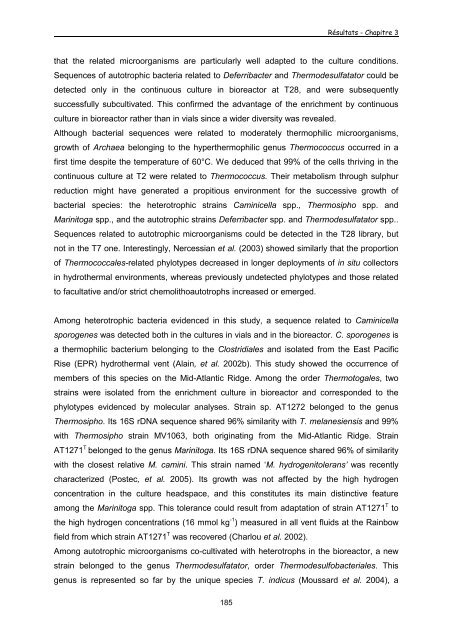THESE Anne POSTEC Diversité de populations microbiennes ...
THESE Anne POSTEC Diversité de populations microbiennes ...
THESE Anne POSTEC Diversité de populations microbiennes ...
You also want an ePaper? Increase the reach of your titles
YUMPU automatically turns print PDFs into web optimized ePapers that Google loves.
Résultats - Chapitre 3<br />
that the related microorganisms are particularly well adapted to the culture conditions.<br />
Sequences of autotrophic bacteria related to Deferribacter and Thermo<strong>de</strong>sulfatator could be<br />
<strong>de</strong>tected only in the continuous culture in bioreactor at T28, and were subsequently<br />
successfully subcultivated. This confirmed the advantage of the enrichment by continuous<br />
culture in bioreactor rather than in vials since a wi<strong>de</strong>r diversity was revealed.<br />
Although bacterial sequences were related to mo<strong>de</strong>rately thermophilic microorganisms,<br />
growth of Archaea belonging to the hyperthermophilic genus Thermococcus occurred in a<br />
first time <strong>de</strong>spite the temperature of 60°C. We <strong>de</strong>duced that 99% of the cells thriving in the<br />
continuous culture at T2 were related to Thermococcus. Their metabolism through sulphur<br />
reduction might have generated a propitious environment for the successive growth of<br />
bacterial species: the heterotrophic strains Caminicella spp., Thermosipho spp. and<br />
Marinitoga spp., and the autotrophic strains Deferribacter spp. and Thermo<strong>de</strong>sulfatator spp..<br />
Sequences related to autotrophic microorganisms could be <strong>de</strong>tected in the T28 library, but<br />
not in the T7 one. Interestingly, Nercessian et al. (2003) showed similarly that the proportion<br />
of Thermococcales-related phylotypes <strong>de</strong>creased in longer <strong>de</strong>ployments of in situ collectors<br />
in hydrothermal environments, whereas previously un<strong>de</strong>tected phylotypes and those related<br />
to facultative and/or strict chemolithoautotrophs increased or emerged.<br />
Among heterotrophic bacteria evi<strong>de</strong>nced in this study, a sequence related to Caminicella<br />
sporogenes was <strong>de</strong>tected both in the cultures in vials and in the bioreactor. C. sporogenes is<br />
a thermophilic bacterium belonging to the Clostridiales and isolated from the East Pacific<br />
Rise (EPR) hydrothermal vent (Alain, et al. 2002b). This study showed the occurrence of<br />
members of this species on the Mid-Atlantic Ridge. Among the or<strong>de</strong>r Thermotogales, two<br />
strains were isolated from the enrichment culture in bioreactor and correspon<strong>de</strong>d to the<br />
phylotypes evi<strong>de</strong>nced by molecular analyses. Strain sp. AT1272 belonged to the genus<br />
Thermosipho. Its 16S rDNA sequence shared 96% similarity with T. melanesiensis and 99%<br />
with Thermosipho strain MV1063, both originating from the Mid-Atlantic Ridge. Strain<br />
AT1271 T belonged to the genus Marinitoga. Its 16S rDNA sequence shared 96% of similarity<br />
with the closest relative M. camini. This strain named ‘M. hydrogenitolerans’ was recently<br />
characterized (Postec, et al. 2005). Its growth was not affected by the high hydrogen<br />
concentration in the culture headspace, and this constitutes its main distinctive feature<br />
among the Marinitoga spp. This tolerance could result from adaptation of strain AT1271 T to<br />
the high hydrogen concentrations (16 mmol kg -1 ) measured in all vent fluids at the Rainbow<br />
field from which strain AT1271 T was recovered (Charlou et al. 2002).<br />
Among autotrophic microorganisms co-cultivated with heterotrophs in the bioreactor, a new<br />
strain belonged to the genus Thermo<strong>de</strong>sulfatator, or<strong>de</strong>r Thermo<strong>de</strong>sulfobacteriales. This<br />
genus is represented so far by the unique species T. indicus (Moussard et al. 2004), a<br />
185
















